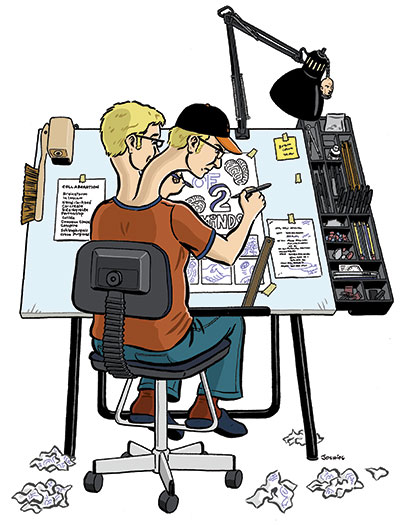Booth, which is the literary journal of the Butler University graduate writing program (more of them in a future post), asked me to write about my comics-creating process for a recent issue. Since this was a frequent topic with my Associates during my just-completed ACA residency, I thought this might be relevant…
 How I Write
How I Write
I create comic books, so I write in pictures—and draw with words. I’ve learned over the years that the uniqueness of the comics form is the dual experience of reading and seeing.
But even though the experience of reading a comic is unified, when I create a comic I break my creative tasks down into two distinct parts: writer and artist. Both stages use different parts of my brain, and both allow me to edit and revise the work as it moves forward. So even though my routine is regimented I always make room for serendipity and artistic surprise.
I begin by writing out the story in prose form, always with the goal of showing as much as possible through action and dialogue. I then break down the text into the key moments of narration that will become the individual comics panels. The final script includes short descriptive sentences of what’s going on in each panel—clues and directions to my “artist self”—and all character dialogue, narration or “voiceover” captions, and sound effects. It reads much like a screenplay.
Once the script is done, I step away from the computer and move to the drawing table. (Although much of my work has first been “published” on the Internet, I’m old-fashioned in the sense that I draw entirely by hand.) I lay out the script, breaking it down into thumbnail sketches, using minimal detail, just enough to block out word balloon and character placement. Through thumbnailing, I assess the story’s pace, check its momentum, and see how it flows from panel to panel and page to page. During this stage, I often find ways to condense elements, or, conversely, to flesh out certain scenes.
Next comes penciling, the most time-intensive part of the comics-making process. That’s when I scale up my thumbnails to full-size, drawing in the panel borders, characters, backgrounds, and lettering elements on tabloid-size paper. Again, when translating the layouts to this larger size, I often find better artistic or storytelling solutions. On a good day, I can pencil an entire detailed page from start to finish.
Inking is the most fun of the part of process for me. It’s when the story finally comes into complete focus, as I shape the pencils into finished art, often taking away lines more than anything else. I love the physical act of inking: the gentle pressure of the brush on the page, and the endless tiny aesthetic choices that go into each stroke. In the end, the art looks pretty much the way it will appear on the printed page.
Not every cartoonist works the way I do; many have a much looser system, and some create their work completely organically, literally writing and drawing the story at the same time. And sometimes I too find ways to skip steps along the way. But this “two-headed monster” approach works for me, and helps me break down into manageable steps what can often seem a daunting task—translating the ineffable images in my head into distinct visual form.
